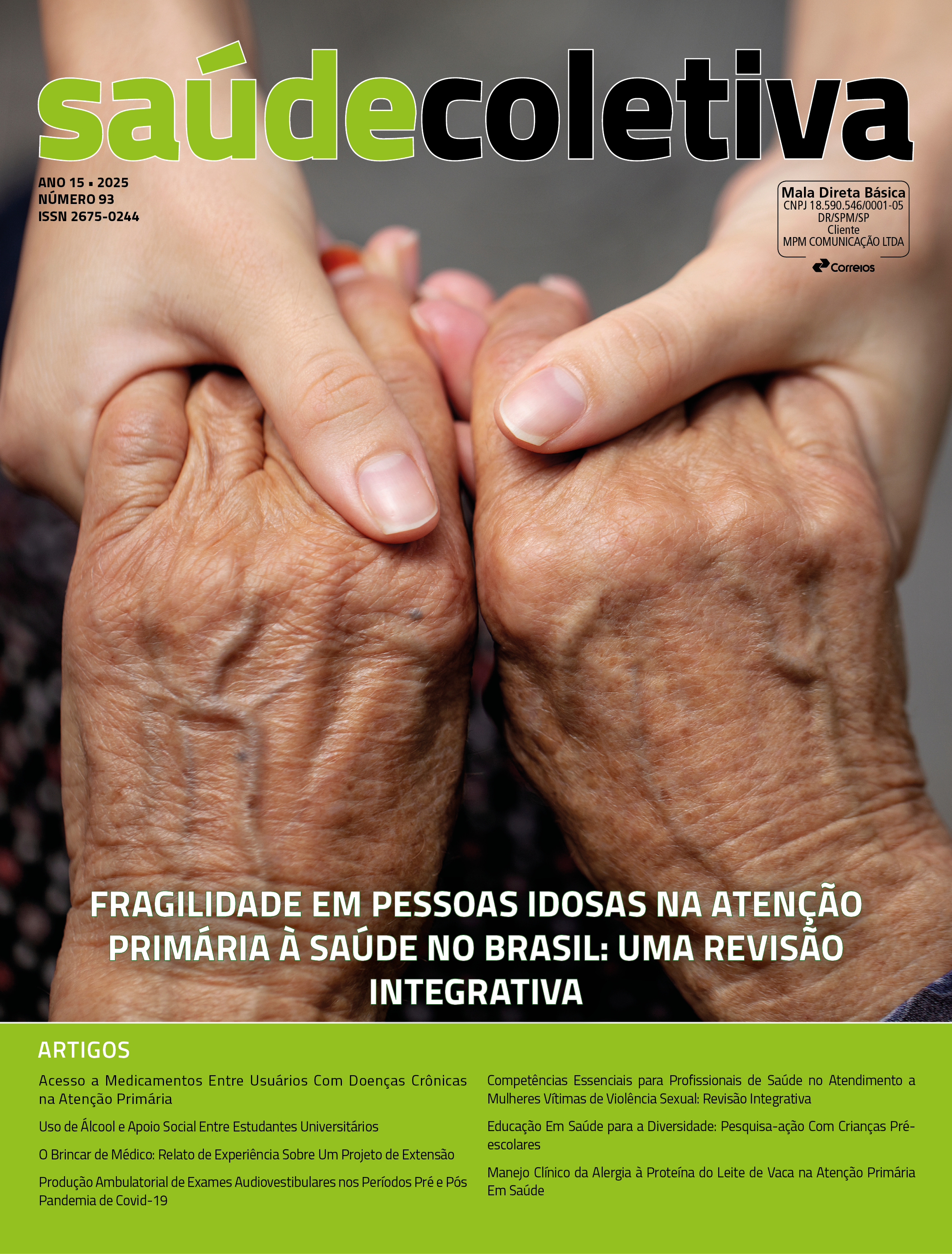Outpatient Production of Audiovestibular Examinations in the Pre- and Post Covid-19 Pandemic Periods
DOI:
https://doi.org/10.36489/saudecoletiva.2025v15i93p14480-14491Keywords:
Covid-19, Hearing, Vestibular System, SUS, PandemicAbstract
Objective: To study the outpatient production of auditory and vestibular exams in the pre-pandemic, during-pandemic, and post-pandemic periods. Methods: Ecological study with secondary data provided by the Ambulatory Information System of the Unified Health System, including auditory and vestibular exams conducted in Brazil and the five federal regions between the years 2018 and 2023. The collected data were analyzed descriptively, tabulated, and presented in graphs and tables. Results: A national decrease in the production of auditory (-27.9%) and vestibular (-30.7%) exams was observed during the pandemic, with a continued negative trend (-3.9%) in the post pandemic period for auditory exams, but with an increase in vestibular exams (+3.6%). The Southeast region showed the highest production rates for both exams, while the North region had the lowest. Conclusion: The findings suggest that the outpatient production of audiovestibular exams followed the dynamics of confinement, with a decrease in production followed by a subsequent increase, especially in vestibular exams.
References
M. Da Silva C, Soares R, Machado W, Arbilla G. The COVID-19 Pandemic: Living in the Anthropocene. Rev Virtual Quím. 2020;12(4):901–12.
Ferreira RJS. Condições audiovestibulares e suas repercussões em recuperados da covid-19. PPgFon. 2022;1:14-5.
Ribeiro GE, Silva DPCD. Audiological implications of COVID-19: an integrative literature review. Rev CEFAC. 2021;23(1):e9620.
Borges CM, Barreto EKR, Nogueira JPD, Guerra PDF, Barros LN. Alterações otológicas em pacientes infectados pelo Covid-19: uma revisão das manifestações e efeitos na orelha interna. Res Soc Dev. 22 de novembro de 2022;11(15):e444111537566.
Castro ASOD, Gazzola JM, Natour J, Ganança FF. Versão brasileira do DizzinessHandicap Inventory. Pró-FonoRev Atualização Científica. abril de 2007;19(1):97–104.
Patatas OHG, Freitas C, Ganança FF. Qualidade de vida de indivíduos Qualityoflifeofindividuals submetidos à reabilitação submittedto vestibular vestibularrehabilitation. Braz J Otorhinolaryngol. 2009.
Dos Santos CFM, Monteiro MS, Sendeski LAM, Gonçalves JBDS. Complicações audiovestibulares na COVID-19: uma revisão integrativa. Braz J Health Rev. 23 de maio de 2023;6(3):10288–308.
Viana É, Rocha FR, Rosa A, Sevarolli R, Honorato SG. Alterações audiovestibulares em pacientes pós-infecção de Covid-19.
Figueiredo MC, Atherino CCC, Monteiro CV, Levy RA. Antimaláricos e ototoxicidade. Revista Brasileira de Reumatologia. 2004;44:212-4.
Sousa MD, Andrade CL, Braite N, Rabelo MB, Oliveira CS, de Souza MC, et al. Impactos na saúde auditiva de crianças e adolescentes decorrentes da pandemia da COVID-19. J Multiprofessional Health Research. 2021;2(2):e02-107.
De Oliveira PF, De Jesus AS, Oliveira ABS, Dos Santos SVR, De Lima AGS, Falcão OFR., Reis LA. Autorreconhecimento da sintomatologia do zumbido em indivíduos brasileiros durante o período da pandemia de COVID-19. PeerReview, 5(15), 74–88. (2023).
Conselho Nacional de Saúde. Recomendação nº 036, de 11 de maio de 2020. Disponível em:<https://conselho.saude.gov.br/recomendacoes-cns/1163-recomendac-a-o-n-036-de-11-de-maio-de- 2020>.
Ministério da Saúde - COVID-19 NO BRASIL. Departamento de Monitoramento e Avaliação de (DEMAS) da Secretaria de Informação e Saúde Digital (SEIDIGI). Disponível em: https://infoms.saude.gov.br/extensions/covid-19_html/covid-19_html.html.
IBGE. Instituto Brasileiro de Geografia e Estatística. Censo 2022: Panorama. Disponível em:<https://censo2022.ibge.gov.br/panorama/>.
Andrade CLO, Fernandes L, Ramos HE, Mendes CMC, Alves CAD. Programa Nacional de Atenção à Saúde Auditiva: avanços e entraves da saúde auditiva no Brasil. Revista Ciências Médicas e Biológicas, v.12, p.404-410, 2013.
De Sousa MFS, Do Nascimento CMB, Sousa FOS, Lima MLLT, Silva VL, Rodrigues M. Evolução da oferta de fonoaudiólogos no SUS e na atenção primária à saúde, no Brasil. Rev. CEFAC 19 (2) • Mar 2017.
Ribeiro JM, Moreira MR, Ouverney AM, Da Silva CMFP. Políticas de saúde e lacunas federativas no Brasil: uma análise da capacidade regional de provisão de serviços. Ciênc. saúdecolet. 22 (4) Abr 2017.
Oliveira RAD, Duarte CMR, Pavão ALB, Viacava F. Barriers in access to services in five Health Regions of Brazil: perceptions of policymakers and professionals in the Brazilian Unified National Health System. Cad. Saúde Pública. 2019;35(11):e00120718.







